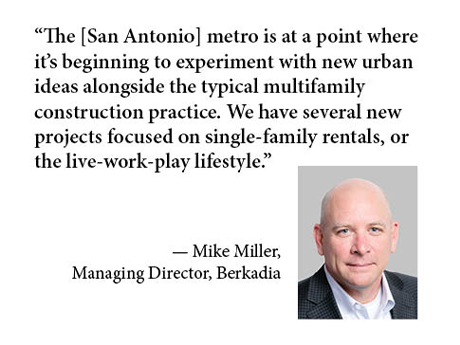Along with Dallas and Houston, San Antonio is one of three powerhouse multifamily markets that make up the Texas Triangle. Multifamily & Affordable Housing Business asked Mike Miller, managing director for Berkadia San Antonio, for his take on the metro area’s investment and development trends.
MAHB: On the map, how does Berkadia define the San Antonio multifamily market?
Miller: Our team defines and services San Antonio proper as well as Boerne and New Braunfels, additionally, we cover the remainder of South Texas.
MAHB: Berkadia’s latest report card has deliveries as 7,895 units in 2023 and absorption at 5,986. Other data sets indicate the supply-demand void is going to widen in the future, with about 12,000 units expected to deliver in 2024. Data can be somewhat subjective, so can you explain some of the nuances of the delivery/absorption situation in San Antonio, especially as there are a lot of stories saying this market is oversupplied?
Miller: ‘Oversupplied’ is a simplified diagnosis for a complicated condition, but we can agree that multifamily stock across the Sun Belt is outpacing current demand, mostly due to the economic pressure caused by COVID-19 and current interest rate hikes.
If we compare San Antonio alongside the other top 10 metros of the country, we’re one of the few to see population growth carrying over from 2020 into 2023. We’re confident that, as absorption remains positive, as it has over the past two years, the occupancy of San Antonio will continue to correct itself for the better.
MAHB: Can you compare the number of units under development with the metro’s total stock?
Miller: San Antonio’s new construction, regarding completed projects in 2023, consists of approximately 7 percent of the total stock in the city. We’re diligently tracking the properties that are scaled back due to fundraising or zoning exposure and those put on hold for similar reasons.
However, we’re also considering the impact of 2023’s reduction in permitting, assuming that in the future as the pipeline dwindles due to lack of permits, properties completed in the medium term, between 2024 and 2026, will counterbalance the current notion of excess supply.
MAHB: What areas of the metro are seeing the most growth right now and why?
Miller: Both Boerne and New Braunfels are growing quickly. New Braunfels is experiencing exponential growth as it is integrated into the investment powerhouse that is the Texas Triangle: Dallas, Houston and San Antonio. At a submarket level, we’re seeing the best performing submarkets in the West/Far West Side, Alamo Heights and emerging success on the Southside of San Antonio. Market rate properties continue to shine along the 1604 corridor leading to New Braunfels. (Loop 1604 is the outer highway loop that circles downtown San Antonio.)
MAHB: What type of product is being delivered in these areas? What’s the latest and greatest in local development trends?
Miller: The metro is at a point where it’s beginning to experiment with new urban ideas alongside the typical multifamily construction practice. We have several new projects focused on single-family rentals, or the live-work-play lifestyle. Additionally, the city and several groups are pushing for more transport-oriented construction. Although we’re a few years off from a successful implementation of said ideas, these emerging trends will ultimately impact the long-term development strategy of all involved parties.
Other single-family rental and live-work-play projects are springing up in tandem with 1604, higher education institutions and employment opportunities. Just to name a few, look at the new construction surrounding the Toyota and DeLorean factories, Port San Antonio and Brooks City Base, Texas A&M San Antonio and, of course, the University of Texas at San Antonio.
MAHB: Do you expect more multifamily trades to occur in 2024?
Miller: I believe we’ll see an increase in transaction volume as the Federal Reserve continues to review and re-evaluate interest rates. We are working intimately with our clients as they prepare to tackle opportunities that will come their way. Last year, there were more conversations about how to stay above water during this hold cycle as the markets anticipated the Fed’s actions. This year, our market feedback sounds like studs at the Kentucky Derby, anticipating the gate, and off to the races!
MAHB: This past year, we’ve heard a lot about capital that’s been sitting on the sidelines, riding out the unstable-interest-rate environment. Can you provide a little more insight and color about this pent-up investor demand and how it might play out in San Antonio?
Miller: We’re actively working with our clients to identify properties that complement their strategy. While there was a lull in transactions last year, we know of sidelined capital with interest in the San Antonio market. New funds were raised while sidelined capital reassessed their target goals and interests. Berkadia has been here to advise them all throughout the process.
MAHB: What unique or surprising trends are you seeing emerge in the market that would be most interesting for San Antonio apartment investors to think about this year?
Miller: Thankfully, I think more owners and investors will be surprised by the positive outlook most San Antonio real estate professionals own. Both Texas and San Antonio are pro-investment, opening our clients to opportunities such as the single-family rental market, live-work-play communities and budding metros such as New Braunfels and Boerne.
MAHB: Can you share some market stats?
Miller: Effective rents grew by 1 percent between the fourth quarter of 2022 and the fourth quarter of 2023. During that same period, occupancies dipped by 1.3 percent.
Certainly, we’re lucky enough to not see wild peaks and valleys experienced in other metros. Although, we are seeing a slight downshift in occupancy and absorption this year. We remind ourselves that there is more to the commercial real estate market than just the ‘here and now.’ We’re focused on maintaining the long view and providing excellent service to current and future clients.


